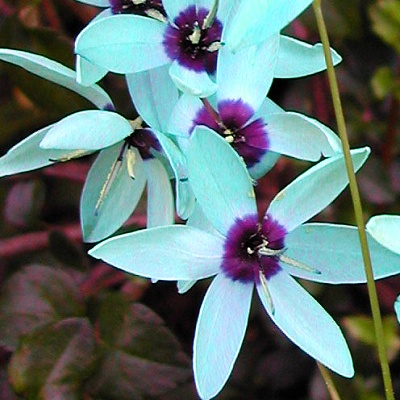Planting the bulbs
When to plant -- Your bulbs (technically corms) will sprout in autumn, so mark your calendar to plant them in late September or early October (in the Southern Hemisphere, late March/April). Until then, store them in a paper bag. Or you may plant them in soil, if it is kept completely dry until autumn. Either way, keep them in a warm spot until then, out of direct sunlight. Note that they may sprout in autumn even if in a bag, so don't wait too long to plant them. Pot size -- Use a tall pot at least 7 inches tall (15 cm), and wide enough so there is 1.5 inches (4 cm) between bulbs, and they are at least 2 inches (5 cm) from the edge of the pot. Avoid dark colored pots, since they absorb more heat. A clay pot is best. Soil -- Use fast-draining soil. A typical mix is 1 part
quality potting soil Planting the bulb -- The top of the bulb is usually pointier and smooth, while the other end may be "puckered", where the roots were attached. If you're unsure which end is "up", just plant it sideways and it will grow upwards. The top of the bulb should be 2 inches (5 cm) under the surface. Only fill the pot to within 1.5-2 inches (4-5 cm) of the top, because you'll be adding more soil later. In late September or early October, water the soil *lightly*. Use only enough water to lightly moisten the soil throughout (not fully saturated), and keep them this moist until they sprout. Keep them between about 50 and 77 degrees F (10-25°C) until they sprout, which should be within a few weeks. Sunlight -- Once they sprout, move them to a sunny spot. This Ixia prefers mostly-sunny conditions. I find they can tolerate less sun in winter if they receive more sun in spring. Some afternoon shade might be needed in regions with strong, hot sun. The flowers have the best color if the bulbs are kept cool throughout the growing season. An easy way to keep them cooler is to place the pot inside a second pot made of clay. If there is space between the two pots, fill it with soil. About 2-3 weeks after they sprout, carefully add more soil until it's up to the rim of the pot. Watering: Aim to keep the soil evenly moist throughout the growing season. Avoid letting it dry out completely, but also
don't keep it constantly saturated. If you're unsure if the soil has the proper moisture
in the root zone, use a
moisture meter Feeding -- This species has relatively low fertilizer requirements. Feed about 2 weeks after they sprout, and again 2 months later. Use an all-purpose fertilizer that contains micronutrients. Avoid feeding them after February (August in the southern hemisphere). Frost protection -- They don't mind cool conditions, but they must be protected from freezing temperatures. You may grow them indoors in a sunny room. Wind protection - The grass-like leaves and flower stems are somewhat fragile and may need protection or support in very strong winds. Dormancy care -- After the plant has flowered in Spring, the leaves will die back as the bulb prepares for dormancy. Reduce watering during this time, giving just enough water to keep the soil from becoming fully dry. The bulbs are at risk of rotting if the soil is too wet during this period. Once the leaves have completely died back, you may either leave them in their pot, or remove the bulbs and separate the baby corms (which are tiny and may be hard to find). Store any removed bulbs in a paper bag in a cool spot until autumn. If you leave them in their pot, ensure that the soil stays dry, and also replant them into fresh soil the second year. Pests -- I've never noticed any insects on them, but mealy bugs are reported to like the bulbs, so if you notice cottony stuff around the base of the stem, try using an insecticidal soap soil drench. Have fun growing them! - Jeff Strange Wonderful Things
|
|||||||||


